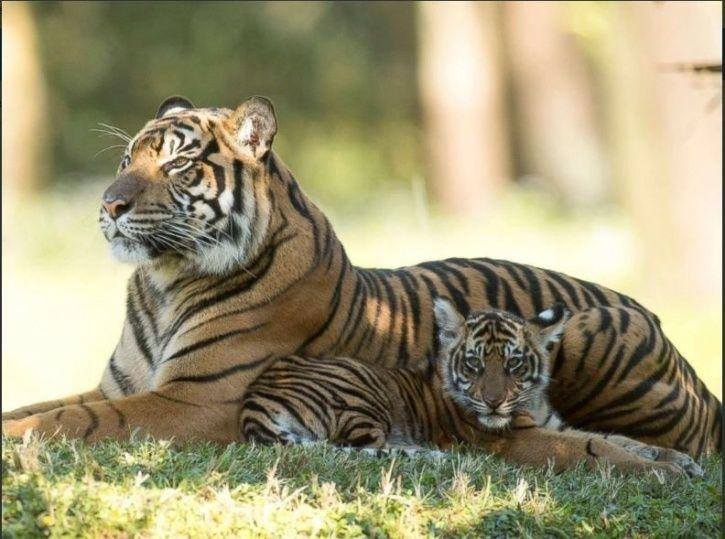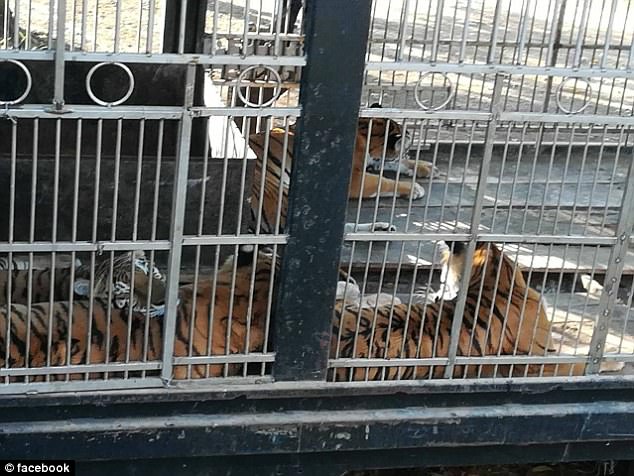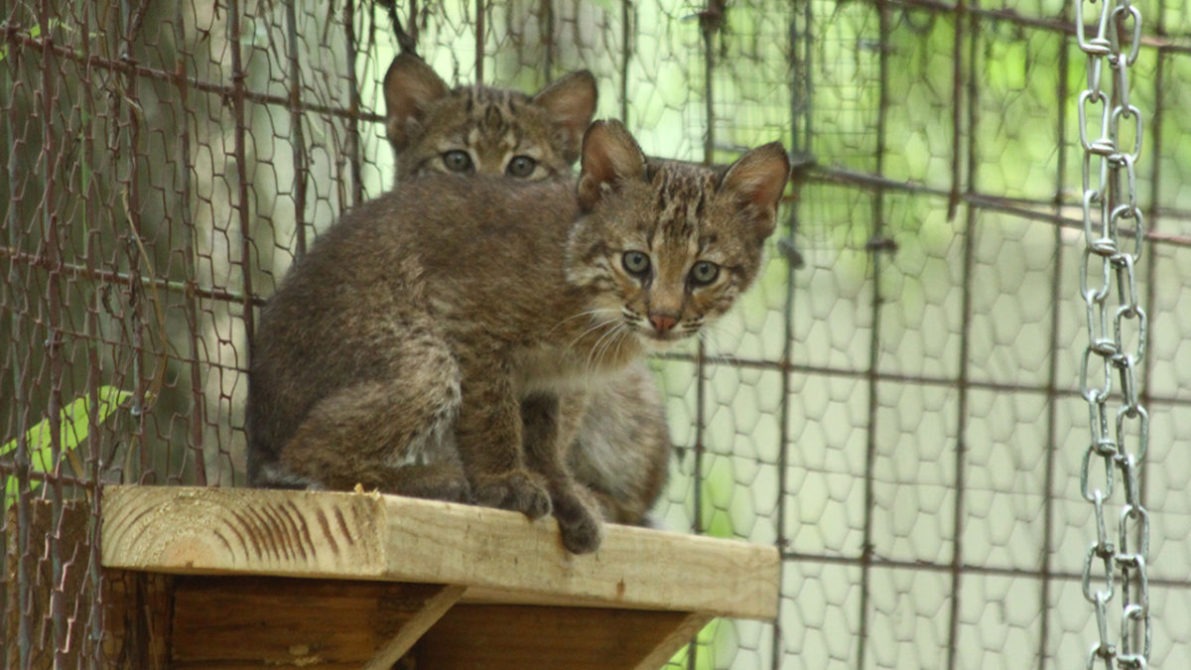Felines on the Loose
America ‘s big cat crisis
Felines on the Loose
By Katie Marsico
 Lions, tigers, leopards, and other big cats elicit a mingled reaction of admiration, awe, and terror. Recently, however, these animals have found themselves at the center of nationwide panic and controversy. On June 22, a 10-year-old Minnesota boy was attacked by a lion and tiger that were privately owned by a man who also kept several other large animals on his property. Both cats were destroyed, and the child was critically injured. A devastating and yet avoidable occurrence, the mauling was unfortunately not the first of its kind to make headlines.
Lions, tigers, leopards, and other big cats elicit a mingled reaction of admiration, awe, and terror. Recently, however, these animals have found themselves at the center of nationwide panic and controversy. On June 22, a 10-year-old Minnesota boy was attacked by a lion and tiger that were privately owned by a man who also kept several other large animals on his property. Both cats were destroyed, and the child was critically injured. A devastating and yet avoidable occurrence, the mauling was unfortunately not the first of its kind to make headlines.
Scott Lope is the General Manager of Big Cat Rescue in Tampa , Florida , and insists that public awareness is the key to halting what is rapidly becoming America ‘s “big cat crisis.”
“These stories about maulings and attacks make the front page for a few days, but the issue needs to be addressed on a more consistent basis,” says Lope. He also emphasizes that the animals in question are too easy to obtain and that private ownership is where the real problem lies. “Whether it’s a well-meaning individual who thinks he’s helping to save a species or someone who’s looking for bragging rights, people are often ill-equipped and unaware of what’s involved in caring for these cats. They seem cute as cubs, but they ultimately get bigger and increasingly aggressive.”
Misinformation Results in Mistreatment
Looking at Nikita today, you might never guess that she wasn’t always this sleek and majestic. The four-year-old African lioness has been a resident of Big Cat Rescue for more than three years. The sanctuary’s mission is to provide permanent care for a collection of rare and exotic cats that have been abused and abandoned, or who are retired from circuses and other exhibitions. Authorities confiscated Nikita from a drug house in Tennessee , where she had been kept chained to a wall. By the time she arrived at Big Cat Rescue, Nikita was malnourished, poorly socialized, and suffering from swelling on her elbows due to confinement on a concrete floor. Lope can attest that Nikita’s situation is sadly not unique.
“People don’t realize the complex nutritional needs big cats have. They don’t understand that they’re physically powerful, social animals who have to be around other members of their species. When Nikita came to us, she had never seen another lion before.” Although public perception may be that circuses and zoos are largely to blame for America ‘s Big Cat Crisis, Lope believes that the problem begins with breeders.
“It’s telling when you consider what it takes to get one trainable performing animal. For every one that does work out, there are hundreds that don’t. Those animals have to go somewhere, and most reputable sanctuaries are absolutely flooded.” American Sanctuary Association Director Vernon Weir agrees and adds that it’s well-intentioned but frequently misinformed people who largely contribute to the problem.
| https://www.bigcatrescue.biz/ |
| https://www.bigcatrescue.biz/ |
“The crisis is really due to the breeding, selling, and trading of these animals,” says Weir. “A lot of people buy them as cubs. You can probably get a tiger cub for anywhere between $1,000 and $5,000. Breeders don’t explain the nutritional or spatial requirements, and they certainly don’t reinforce that the cats grow up to be powerful and dangerous.” Weir emphasizes that the majority of publicized maulings occur when people find themselves disillusioned by the inevitable demands of caring for a big cat. Larger, older, and more aggressive cats end up abandoned, abused, and either headed toward a sanctuary or faced with euthanasia. The result is that most sanctuaries are filled to the brim. These organizations are ultimately forced to cope with the cumbersome financial toll of providing for animals that can no longer be returned to the wild.
Tammy Quist is the Executive Director of Wildcat Sanctuary in Isanti County , Minnesota . Given the high levels of care that the facility’s twenty animals require, Quist contends that the best place for big cats is in the wild.
“Too often people just have no idea what they’re getting into,” she explains. “Our tigers can eat between fifteen and twenty pounds of meat a day. To take proper care of a single animal, it can easily run you $25,000 annually.”
Legislative Loopholes and the Sanctuary Controversy
While there are quite a few solid state laws prohibiting or at least restricting private ownership of big cats, Lope insists that there are just as many ways to get around them.
“Enforcement is truly the issue. There are so many gray areas. Permits aren’t always specific as to the number of animals you can have or the standard of care you need to provide.” Another legislative loophole is the hybridization of wild cats. Without genetic testing to prove that an animal doesn’t belong to a species that private citizens are prohibited from keeping, breeders can easily tell one story to customers and another to government inspectors. Even properly licensed animal exhibitors such as zoos and circuses have the potential to play a role in America ‘s big cat crisis. While such facilities might have to submit to greater legislative scrutiny than private breeders, Weir says the danger lies with roadside zoos and similar small-name, low-budget businesses that keep animals.
“Theoretically, licensed exhibitors shouldn’t be part of the problem,” says Weir. “But we’ve found that some of these smaller industries frequently go broke or shut down, and this results in big cats that end up in sanctuaries or that are abandoned or inhumanely destroyed.”
Adding to the dilemma are sanctuaries that take in more animals than they can legitimately care for, as well as pseudo-sanctuaries that actually manipulate their title to sell, breed, or buy big cats. In extreme cases of this latter occurrence, animals are often slaughtered for their meat or fur or sold to organizers of canned hunts. Organizations such as the ASA and The Global Federation of Sanctuaries (GFAS) offer accreditation to various facilities that meet necessary care and safety requirements. Lynda Sugasa is the Executive Director of the Safe Haven Wildlife Refuge Center in Marengo, Il, and emphasizes the importance of accreditation.
“Often people who try to run a sanctuary have the best of intentions,” says Sugasa, “but big cats are high-maintenance. When they come from rescue situations but don’t go to the proper facility, they don’t have a chance.”
Halting the Crisis in Its Tracks
All too frequently, the public is more attuned to the horror of big cat maulings than the contributing factors and the plight of the animals themselves. Therefore, increased public awareness and stricter enforcement of legislation are crucial to ending the crisis.
“Legislation gets watered down,” explains Quist. “What tough laws do exist require tougher enforcement.” Quist recommends that citizens be active in contacting local animal control authorities if they suspect illegal ownership or abuse of a big cat. Even licensed animal exhibitors should be reported if they don’t appear to be providing adequate and humane standards of care.
Lope adds that another way people can be proactive in protecting big cats is to patronize circuses that don’t use animals or to push for local legislation that would ban traveling circuses in their area. “We find the smaller, roadside circuses usually keep these animals in more deplorable conditions,” says Lope. “If you don’t patronize circuses that feature animal acts, you bring this issue to the forefront because you hit people in their pocket books.” In addition to taking these steps, he concludes that educating the public is a critical part of the solution.
“The public needs to realize that big cats can’t be dumped back in the wild when they’re no longer wanted or easy to care for. The allure of living with something wild or exotic makes people forget that these are large animals-and extremely dangerous predators.”
llinois Speaks out
The people of Illinois are hard at work to end the big cat crisis! The Safe Haven Wildlife Refuge Center in Marengo aims to rescue and rehabilitate a variety of indigenous animals. Bobcats and cougars are among the many species the center houses. These wildcats were all confiscated from situations involving illegal ‘ownership’ and cannot ultimately be returned to the wild.
“Improper and illegal ‘ownership’ of big cats is epidemic across the nation,” explains Executive Director Linda Sugasa. “Laws vary from state to state, and so many wild cats end up in sanctuaries such as our own because they’re bred as fad pets, the ‘species of the month.'”
The center currently sponsors educational programs designed to inform the public about the needs of local wildlife. It also aims to raise public awareness about the cruel effects of the illegal pet trade.
The Safe Haven Wildlife Refuge Center has been accredited by TAOS .
Check out www.SafeHavenWildlife.com for more details.
It is currently illegal in Illinois to privately keep wildcats as pets. Only USDA-licensed exhibitors (zoos, science and research facilities, and refuges) can obtain special permits from the Director of Natural Resources that allow guardianship.
Check out www.Dnr.state.il.us for more details.
Animal-Free Circuses
Refusing to patronize circuses with animal acts is a powerful way to help protect wildcats and to pinch off the continued funding of breeders. Here’s a sampling of popular animal-free circuses:
Bindlestiff Family Cirkus
Presents vaudeville and cabaret performances for audiences of all ages featuring clowns, actors, comedians, and musicians. www.Bindlestiff.org
Cirque du Soleil
Uses original music, creative light displays, and dazzling costumes to present audiences with exciting circus performances. www.CirqueDuSoleil.com
Hiccup Circus
Offers a variety of interactive programs and performances including stilt-walking, acrobatics, and juggling. www.HiccupCircus.com
Katie Marsico is a children’s book editor and freelance author. She is also the proud wife of Carl and the mother of Maria and a variety of four-legged family members.
Help Big Cat Rescue end the practices that result in the abandonment and abuse of big cats by sending an email to your lawmaker through CatLaws.com





